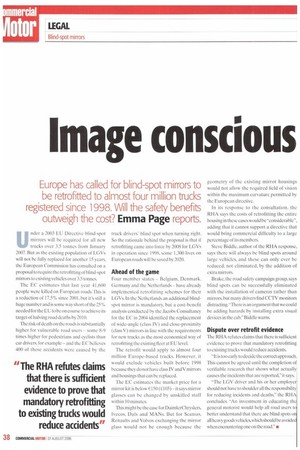mage conscious
Page 38

If you've noticed an error in this article please click here to report it so we can fix it.
Europe has called for blind-spot mirrors to
be retrofitted to almost four million trucks registered since 1998. Will the safety benefits outweigh the cost? Emma Page reports.
lillnder a 2003 EU Directive blind-spot mirrors will be required for all new trucks over 3.5 tonnes from January 2007. But as the existing population of LGVs will not be fully replaced for another 15 years, the European Commission has consulted on a proposal to require the retrofitting of blind-spot mirrors to existing vehicles over 3.5 tonnes.
The EC estimates that last year 41,600 people were killed cm European roads. This is a reduction of 17.5% since 2001, but it's still a huge number and is some way short of the 25% needed for the EU to be on course to achieve its target of halving road deaths by 2010.
The risk of death on the roads is substantially higher for vulnerable road users sonic 8-9 times higher for pedestrians and cyclists than car drivers, for example and the EC believes 400 of these accidents were caused by the truck drivers' blind spot when turning right. So the rationale behind the proposal is that if retrofitting came into force by 2008 for LGVs in operation since 1998. some 1,300 lives on European roads will be saved by 2020.
Ahead of the game
Four member states Belgium, Denmark, Germany and the Netherlands have already implemented retrofitting schemes for their LGVs. In the Netherlands an additional blindspot mirror is mandatory, but a cost-benefit analysis conducted by the Jacobs Consultancy for the EC in 2004 identified the replacement of wide-angle (class IV) and close-proximity (class V) mirrors in line with the requirements for new trucks as the most economical way of retrofitting the existing fleet at EU level.
The retrofit would apply to almost four million Europe-based trucks. However, it would exclude vehicles built before 1998 because they do not have class IV andV mirrors and housings that can be replaced.
The EC estimates the market price for a mirror kit is below €150 (f105) it says mirror glasses can be changed by unskilled staff within 10 minutes, This might be the case for DaimlerChryslers, Ivecos, Dafs and MANs. But for Scanias, Renaults and Volvos exchanging the mirror glass would not be enough because the geometry of the existing mirror housings would not allow the required field of vision within the maximum curvature permitted by the European directive.
In its response to the consultation. the RHA says the costs of retrofitting the entire housing in these cases would be "considerable", adding that it cannot support a directive that would bring commercial difficulty to a large percentage of its members.
Steve Biddle, author of the RHA response, says there will always be blind spots around large vehicles, and these can only ever be reduced, not eliminated, by the addition of extra mirrors.
Brake, the road safety campaign group, says blind spots can be successfully eliminated with the installation of cameras rather than mirrors, but many drivers find CCTV monitors distracting. There is an argument that we could be adding hazards by installing extra visual devices in the cab," Biddle warns.
Dispute over retrofit evidence
The RHA refutes claims that there is sufficient evidence to prove that mandatory retrofitting to existing trucks would reduce accidents.
It is too early to decide the correct approach. This cannot be agreed until the completion of verifiable research that shows what actually causes the incidents that are reported," i t says.
"The LGV driver and his or her employer should not have to shoulder all the responsibility for reducing incidents and deaths," the RHA concludes. "An investment in educating the general motorist would help all road users to better understand that there arc blind spots o all heavy goods vehicles,which should be avoide when encountering one on the road." Is


















































































































































































